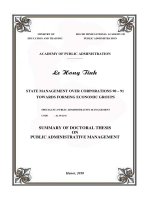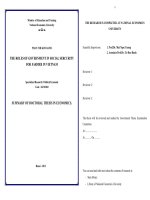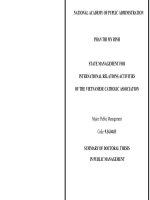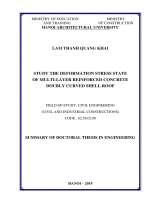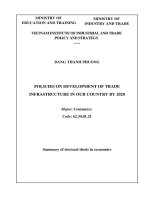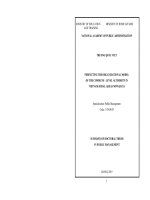Summary of Doctoral thesis in Economics: Cost management accounting in construction ceramic companies in Thai Binh province
Bạn đang xem bản rút gọn của tài liệu. Xem và tải ngay bản đầy đủ của tài liệu tại đây (459.52 KB, 17 trang )
PREFACE
1. Urgency of the thesis topic
Cost and cost management are among the issues that receive special attention from company. It is
because cost represents consumed resources and directly has impact on the quality of products and services,
which is one of three pillars that affect profit. New conditions of business and production require that the
system of theories about management in general and cost management accounting (CMA) in particular to be
improved.
The rapid development of market economy and global integration bring about many opportunities
but also great challenges. In Thai Binh province (Thai Binh), the group of construction ceramic companies
always enjoys strong annual growth of 2025%. Surveys show that, however, accounting activities in
construction ceramic companies in the provincial area only focus on financial accounting rather than support
business management. Accounting staffs have not had enough skills to use CMA’s tools and techniques.
Based on theoretical and practical issues, the author chose the following topic for his doctoral thesis: “Cost
management accounting in construction ceramic companies in Thai Binh Province”.
2. Overview of research
2.1. Studies on creating estimates of operating cost
This is one of important research directions of management accounting (MA) in many decades
because it directly affects cost accounting (CA) and responsibility accounting (RA); it serves as the basis to
measure efficiency and is also used for many purposes such as: planning, allocating resources, co
coordinating operations, motivating and encouraging employees…. (Birnberg et al, 2006).
2.2. Studies on creating strategic cost planning
Current studies about creating strategic cost planning mainly focus on creating target cost planning
for companies. Most studies on target cost focus on the method’s technical aspects, such as: determining
profit target, product price, cost estimates.
2.3. Studies on implementing and controlling operational cost
Studies on implementing CMA focus on identifying cost models, cost distribution and cost function
in companies. Basically, these studies associate the implementation of traditional CA in the context of
modern technology because the development of science and technology has been directly affecting cost
information and changing assumptions of traditional product costs
2.4. Studies in controlling strategic cost and responsibility accounting
Regarding studies on controlling strategic cost, Tomkins và Carr (1996) stated that even though
existing studies achieved certain results, they did not present a general method so that MA data could support
the analysis of product value chain in companies. As for RA , in general, most studies agreed that the
accounting system is designed to highlight cost control via evaluating the responsibility of individuals who
are in charge of controlling cost in each units of companies.
2.5. Studies on cost efficiency based on the general management system of companies
Most notable studies are those evaluating cost efficiency based on the Total Quality Management
(TQM) system of companies. Synchronized, comprehensive or total quality management is first and
foremost a management philosophy in which TQM focuses on improving the quality of products and
services in companies.
2.6. Studies on implementing CMA at Vietnamese and foreign production companies
Regarding this, most existing studies in the world focus on issues related to checking influencing
factors of the application of cost accounting system in specialized production and service providing
companies (Brierley et al, 2001; Fullerton and Mcwatters, 2004) for example at hospitals, schools, banks,
steel or car manufacturing companies….In Vietnam, studies on implementing CMA at companies can be
divided into three groups: studies on building the model of CMA, on implementing CMA in companies, and
on CMA based on the approach to technical processes.
2.7. Studies on influencing factors of CMA in companies
As of now, studies in the world on identifying influencing factors of applying CMA in companies are
quite modest compared to similar studies on MA. Some recent studies are those of Abdel – Kader (2008),
Tuan Mat (2010), and Lucas (2013). In Vietnam, recently there are several notable studies analyzing
influencing factors of applying management accounting, including CMA, in companies by Tran Ngoc Hung
in 2016 and Nguyen Thanh Hung in 2017
2.8. Identifying research gaps for the thesis
Regarding the thesis content, studies on CMA have the following general research gaps: studies on
the theory and practice of CMA to service business management functions are limited by several activities.
Influencing factors of the application of CMA in actual production of companies of different scale and in
different areas are identified by have low representativeness. Indepth studies on CMA need to be further
carried out at companies of different scales and in different fields. It is especially necessary for construction
ceramic companies because previous studies mostly focus on financial accounting (FA).
3. Research objectives and tasks
The thesis aims to systemize and clarify theoretical basis related to CMA to serve business
management functions and influencing factors of the application of CMA in companies. From that, the thesis
presents the reality and provides a system of solutions to increase the application of CMA in construction
ceramic companies in Thai Binh. To achieve these objectives, the thesis identifies 5 basic tasks.
4. Research object and scope
Research object: The thesis studies CMA in construction ceramic companies in Thai Binh.
Research scope: The thesis focuses on studying and systemizing theories of CMA to serve business
management functions at all construction ceramic companies in Thai Binh.
5. Research questions and methodology
5.1. Research questions
Q1: How do you think about CMA with management functions in manufacturing enterprises and
what factors influence CMA application in manufacturing enterprises? Q2: How does CMA apply CMA in
construction ceramics enterprises in Thai Binh province? Q3: What are the solutions for CMA to better meet
the management functions and be more advantageous in construction ceramics enterprises in Thai Binh
province?
5.2. Research methodologies
5.2.1. The overall research process
To complete the thesis, the overall research process consists of 5 steps. Step 1: Select method of
synthesizing theory and data collection methods and tools. Step 2: Select samples, investigate to test and
complete the content of 2 questionnaires. Step 3: Collect relevant primary and secondary data. Step 4:
Processing data of questionnaires and interviewing experts to discuss statistical results. Step 5: Making
conclusions on the status of economic and economic development with the management functions and
factors affecting the application of the economic and technical development as a basis to improve and
enhance the application of economic efficiency in the enterprises producing ceramics on the construction.
Thai Binh province.
5.2.2. Practical methods
5.2.2.1. Methods of document synthesis; 5.2.2.2. Observation method; 5.2.2.3. Interview method;
5.2.2.4. Questionnaire method; 5.2.2.5. Professional solution. To find the answer to the second question of the
thesis, the author designed 2 questionnaire tables. Including the CMA Direct Questionnaire for corporate
governance functions and the Questionnaire for factors affecting the CMA application.5.2.2.4. Sample
selection
5.2.3. Methods of processing and analyzing data
After completing the data collection plan and selecting the research sample, the author conducts data
collection through the main methods of sending direct questionnaires, sending letters and sending them
online. To ensure the reasonableness of the data before analysis, from the respondents' responses, review and
check the quality of each questionnaire. The data is then encoded, input and processed in the form of
statistics described on SPSS software.
6. Contributions of the thesis
In terms of theory: The thesis summarizes and approaches the economic theory of economic
relations associated with the corporate governance functions. Besides, the dissertation identifies three groups
of factors affecting the application of the economy and economy: human factors, organizational factors,
external factors.
In terms of practice: The thesis has identified the situation of methods and techniques that KTQPP
is being used; identify the current situation of factors affecting the application of economic efficiency in the
ceramics manufacturing enterprises in Thai Binh province, as a basis to provide a system of solutions to
improve the efficiency of the economic efficiency with each functions of governance and strengthening the
application of economic efficiency in enterprises.
7. Structure of the thesis
In addition to preface and conclusion, the thesis has three chapters:
Chương 1: Theoretical framework of cost management accounting in production companies.
Chương 2: Reality of cost management accounting in construction ceramic companies in Thai Binh. Chapter
3: Solutions to improve cost management accounting in construction ceramic companies in Thai Binh
CHAPTER 1
THEORETICAL FRAMEWORK OF COST MANAGEMENT ACCOUNTING IN PRODUCTION
COMPANIES
1.1. Identify and classifying cost in production companies
1.1.1. The nature of cost
There are many ways to define cost; however, according to the author, the nature of cost in
production companies nowadays needs to be associated with management activities of each company.
Therefore, it should be considered “current and future incurred cost associated with plans, products and
services of a company”.
1.1.2. Classifying cost
Cost is analyzed from many aspects. Within the thesis’s scope and related to the thesis topic, the
author generalizes several criteria of classifying production cost according to operational function, relation
with the period of business result, relations with operation level or cost behavior, inductive ability into cost
object, serving decisionmaking, and according to decisionmaking authority
1.2. Business management functions and requirement of cost management accounting
information to serve executives
1.2.1. Business management functions
The thesis approaches business management functions from two directions: according to
management process and business fields of companies with 4 basic functions: planning, implementation,
leading and checking/evaluating
1.2.2. Viewpoint and role of cost management accounting
In essence, the author believes that: “Cost management accounting is a component of the business
management system and it belongs to the system of cost management accounting information to identify,
measure, analyze, provide cost information in the process of implementing the organization's goals. Such
information helps managers plan, organize implementation, check and evaluate the implementation situation
and make appropriate decisions to optimize the organization's objectives.”. This is considered as the author's
view throughout the study of cost management accounting.
In terms of role, in its simplest form, the role of CMA can be understood as the collection, recording,
and synthesis of useful cost information to serve decisionmaking. Nowadays, MA displays great changes,
participates deeply into management activities, and help companies optimizes their targets.
1.2.3. Requirement of cost management accounting cost to serve business functions
(1) Regarding the planning: CMA can concretize goals into levels of planning (2) Regarding
implementation: CMA reflects implementation information of cost contents including input, production and
output costs through specialized methods and techniques of CMA (3) Regarding cost control and
evaluation: CMA assists executives in directing and leading companies to reach and exceed targets via
continuously controlling daily cost to increase operational efficiency (4) Regarding decisionmaking: CMA
asists the decisionmaking process via specialized analysis methods.
1.3. Cost management accounting with business management functions
1.3.1. Cost management accounting with the planning function
To serve the planning function, CMA focuses on three contents: creating cost norms, creating
operational cost and creating planning of strategic cost.
1.3.2. Cost management accounting with the implementation function
To serve the implementation functions, CMA focuses on the application of appropriate cost model
for each specific cost identification method to timely provide information of operational cost.
1.3.3. Cost management accounting with cost control and analysis function
To help executives perform this function, CMA collects target cost information (including strategic
cost) and cost incurred during the implementation process. Through related cost reports, accountants
compare, analyze, and identify influencing factors and responsibility of related units to assist executives in
making timely adjustment of decisions during the implementation process.
1.3.4. Applying cost management accounting information for making decisions
This includes applying the relation among costvolumeprofit, analysis of breakeven points and
analysis of relevant information for the decisionmaking process.
1.4. Influencing factors of the application of cost management accounting in companies
Based on basis factors from theoretical framework, the author synthesizes the following groups of
influencing factors: human factor including executives and accountants; information technology (IT);
infrastructure; level of delegation and responsibility; product; company size; corporate culture; cost for
investment; business strategy; state ownership level; external factors including business environment, global
integration, and legal policies of the government related to accounting.
1.5. Cost management accounting in developed countries in the world and experience lessons
for Vietnamese companies
The author focuses on studying CMA in the US, Germany, and Japan and then draws 6 experience
lessons for Vietnamese companies.
CONCLUSION OF CHAPTER 1
The thesis’s theoretical framework starts with the identification and classification of cost; viewpoint,
role and requirement of CMA information to assist executives. With the consistent viewpoint of using CMA
to serve business functions, thesis systemizes basic contents of CMA related to the functions of planning,
implementation, checking and evaluation as well as the application of CMA information to assist decision
making. In addition, the thesis identifies 3 groups of factors related to the ability of applying CMA in
companies and draws 6 experience lessons for Vietnamese companies based on practical experience in the
US, Germany, and Japan so that CMA can be effectively applied in production companies.
CHƯƠNG 2
REALITY OF COST MANAGEMENT ACCOUNTING IN CONSTRUCTION CERAMIC
COMPANIES IN THAI BINH
2.1. Overview of the ceramic industry and construction ceramic companies in Thai Binh
2.1.1. History of establishment, development and market of construction ceramic products in
Vietnam
Ceramic industry is one of traditional industries that developed a long time ago. At present, there are
many Vietnamese products of good quality in the construction ceramic market. However, domestic products
have fierce competition from imported products. Some reasons why domestic products have not dominated
the market are due to limited scale and technology; they have not yet created new consumption trend,
2.1.2. Overview of construction ceramic companies in Thai Binh
As of the end of 2017, there are 30 construction ceramic companies, mostly located in Tien Hai
district. In terms of legal status, most of them are limited companies which are previously private companies;
some are joint stock companies which are previously state enterprises. In terms of scale, most of them at
least have medium size; some have very large scales.
2.1.3. Characteristics of management apparatus and production technology of construction
ceramic
2.1.3.1. Characteristic of management apparatus
The management apparatus of construction ceramic companies in Thai Binh is organized according
to the online functional model.
2.1.3.2. Characteristic of production process and technology
The production of construction ceramic products includes complicated technology and is a
continuous process with many successive stages according to certain order. Each stage creates semi
products. Semiproducts of the previous stage are products of the next stage. Products are massproduced in
large quantity.
2.1.4. Characteristic of accounting activities
The accounting apparatus of construction ceramic companies in Thai Binh is organized according to
the centralized model. Attention has not been given in assigning personnel for management accounting.
Accounting policies and mechanism are not properly executed.
2.1.5. Characteristics of companies that affect cost management accounting
Firstly, CMA is subject to fluctuations in input price and is closely associated with the real estate
market. Secondly, the environment is highly competitive. Thirdly, the sector is likely to cause significant
environmental pollution with large investment costs.
2.1.6. Identifying and classifying cost in companies
Results show that all companies use basis criteria to classify cost according to functions, relation
with the period of business result and inductive ability into cost objects. A few classify cost according to the
relation with level of operation and according to decisionmaking authority.
2.2 Reality of cost management accounting regarding business functions in construction ceramic
companies in Thai Binh
2.2.1. Reality of cost management accounting with planning function
2.2.1.1. Reality of creating cost norms
Procedure of creating cost norms
The building, verification process of cost norms often has 5 steps
Method of identifying production cost norms
+ Direct material cost norm: Norm of main material is the total norms of using and allowance for
loss. Norm of main material price is usually calculated based on the previous year’s average price to predict
market price with relatively stable input factors. The same way is used to calculate norms for direct sub
material cost.
+ Direct labor cost norm: It is calculated for each stage, based on the average standard daily output
and daily wage level of direct production workers. Norm for wage deduction is calculated according to
regulation.
+ General production cost norm: Survey results show that only 50% of companies create this norm
but at different levels.
Method of identifying norms for nonproduction cost
There is no norm for nonproduction cost or norm is created generally, similar to norm for general
production cost.
2.2.1.2. Reality of creating operational cost estimate
Objective and system of operational cost estimates that are being applied: The creation of
operational cost estimate receives attention from the corporate accounting units.
Procedures of creating operational cost estimates: Bases to create operational cost estimates
are targets and specific annual business provided by company managers based on resolutions General
Meeting of Shareholders or Members' Assembly.
Method of creating production cost estimates
+ For direct material cost: It is created annually for direct main material and direct submaterial.
+ For direct labor cost: It is created annually including wage and wage deductions of direct
production workers.
+ For general production cost: It is created annually based on estimates of incurred cost related to
each activity of in the factory, number of officers and employee in the factory and some specific cost norms
for each activity in the year.
Method of create estimates for nonproduction cost
It is created annually with focus on several cost categories of sales and business management costs.
2.2.1.3. Reality of creating strategic cost planning
Statistics show that all companies have not created strategic cost planning.
2.2.2 Reality of cost management accounting with the implementation function.
2.2.2.1. Regarding the accounting model of production cost
Most companies apply the model of actual cost; the ratio of companies applying the model of actual
cost combined with cost estimate is only 16,67%.
2.2.2. Regarding the identification of production cost
About cost center
It is done according to each product line; no company collect cost according production stages.
About collecting initial cost information: The system of document that construction ceramic
companies in Thai Binh use includes documents reflecting direct material cost, labor cost, general production
cost, cost of sales and business management cost.
Processing, recording cost information in accounting accounts: For production cost, use
accounts 621, 622, 627, and 154 to record information; for nonproduction cost, accounts 641, and 642.
Presenting information in the reporting system of accounting cost
After being recorded in details books and general books, cost information is periodically reflected in
the reporting system of cost. Companies have not created cost reports according operation and their reports
have not met the information requirement of business management activities.
2.2.3. Reality of cost management accounting with the function of cost control and evaluation
Managing cost when companies carry out research and production of new products: Several
companies pay attention to this; accountants work with related unit to control production cost of trial
product and determine total estimated cost and ratio of each type of cost to calculate profit. Controlling
daily operational cost: accountants perform this indirectly through controlling productivity, quality, and
efficiency of each unit on the relation between input costs and output results, especially at production
factories. Evaluating fluctuations of key operational cost categories: Many companies perform monthly
cost evaluation but there are also companies do so on a annual basis. In terms of content, companies
normally evaluate cost categories of big ratio, especially direct production cost. Evaluating fluctuations of
operational cost ratio in companies: Most accountants have not paid attention to the evaluation of
information of basic operational cost ratio. Evaluating operational efficiency of strategic cost and cost
centers: 100% of companies have not performed evaluation of operational efficiency of strategic cost and
control responsibility at cost centers.
2.2.4. Reality of applying information of cost management accounting to assist the decision
making process
Most companies have not applied such techniques like costvolumeprofit analysis, breakeven point
analysis, and analysis of relevant information to assist the decisionmaking process.
2.3. Influencing factors of the application of cost management accounting in construction
ceramic companies in Thai Binh
2.3.1. Description of research sample
2.3.2. Descriptive statistics results of the impact of human factor
Synthesized results of factors
Table 2.22: Synthesized influencing factors of cost management accounting in construction ceramic
companies in Thai Binh
No
Group of factor
General
average
point
Standar
d
deviatio
n
I.
Human factor
1.
Executives
4,27
0,439
2.
Accountants
3,31
0,719
II.
Organization factor
1.
Information technology infrastructure;
3,63
0,934
2.
Level of delegation and responsibility
3,64
0,898
3.
Product
3,36
1,021
4.
Company size
3,59
0,822
5.
Corporate culture
3,65
0,908
6.
Cost for investment
3,46
1,065
7.
Business strategy
3,68
0,757
8.
State ownership level
2,97
0,435
III.
External factors
1.
Competition
3,58
0,968
2.
Legal policies of the government
3,24
0,808
(Source: Synthesized data of the author using SPSS software results)
2.4. General evaluation of the reality of cost management accounting and influencing factors of the
application of cost management accounting in construction ceramic companies in Thai Binh
2.4.1. About the reality of cost management accounting regarding business function
Besides obtained results of CMA in companies, there are still a number of technical issues related to
cost classification and the assistance of accounting for each function of business management.
2.4.2 About the reality of influencing factors of cost management accounting in companies
Considering the general average point, executive is the factor with biggest impact on the application
of CMA in companies with the average point of 4.27. However, state ownership level is rated lowly with the
average point of 2.97, below the level of no comment (3 point).
2.4.3. Reason
Objective reasons
Subjective reasons
CONCLUSION OF CHAPTER 2
The author generalizes results of research in the following contents: Firstly, the thesis generalizes the
history of establishment, developmnet; characteristics of management apparatus, production process and
technoligy, and accounting activites. Secondly, results of studying the accounting database system show that
besides obtained results, there are common shortcomings in ecompanies from contents related to cost
classification to tools and methods used in CMA to serve business functions. Thirdly, influencing factors of
CMA application identified and the general average score is calculated based on evaluations of respondents.
Reasons for obtained results and shortcomings are identified.
CHAPTER 3
SOLUTIONS TO IMPROVE COST MANAGEMENT ACCOUNTING IN CONSTRUCTION
CERAMIC COMPANIES
IN THAI BINH
3.1. Development orientation of construction ceramic companies in Thai Binh
Thai Binh province identifies 4 main viewpoints for the development of construction ceramic
industry, including: investment in sustainable market development of ceramic tiles, sanitary ware and paving
stones; development of production units in relation with rational use of natural resources, emission reduction
and environmental protection; production of ceramic tiles, sanitary ware and paving stones to meet the
provincial, domestic and export demands; investment and development of production units towards
centralized direction, medium and large scale with modern technology.
3.2. Principles and requirements to improve cost management accounting in construction
ceramic companies in Thai Binh
3.2.1. Principles for improvement
Firstly, contents to improve CMA help to assist an effective management framework. Secondly, they
are directed towards executives are levels because they are the main subjects of using information for
making decisions. Thirdly, they can be inherited. Fourthly, they are directed towards sustainable
development, improved competitiveness and global integration.
3.2.2. Requirements
Firstly, ensure practical use and effectiveness. Secondly, ensure the provision of information in an
honest, objective and timely manner. Thirdly, match with the characteristics of production, business,
production technology and business management in companies. Fourthly, match with the respirces,
requirements, competence level of the team of executives and accountants.
3.3. Solutions to improve cost management accounting in construction ceramic companies in
Thai Binh
3.3.1. Improving cost identification and classification in companies
Priority should be given to two methods of clasification: according to inductive ability into cost
objects and relation with operation level. This not only helps control operational cost but also helps identify
the function to estimate production cost as below:
E
in which F is the total estimated production cost and is the total estimated quantity of product No.i.
3.3.2. Improving cost management accounting with the planning function
3.3.2.1. Improving the creation of cost norm system in companies
The adjustment of cost norms is only performed in certain situations. Based on calculated norms in
ideal production conditions, there must be fluctation in the rage of 12% during implementation. For direct
labor cost norm: it is recommended that there should be changes, especially using trial time clock for the
criteria of time loss. For general production cost: Accountants need to proactively determine components
of general production cost in companies and based on characteristics of each type of cost to identify it as
fixed cost or variable cost. The norm for plaster mold needs to be determined appropriately. During the
process of creating norm, the criteria for allocation need to be chosen appropriately so that general
production cost can be allocated for each cost object. The chosen criterion can be the total working hour of
direct labor or allocation according to total direct cost. For nonproduction cost: Accountants can use
similar method like with general production cost
3.3.2.2. Improving cost estimate system in companies
At present, the strategy of low price with good quality needs to be considered first and foremost
before building any plan and estimate, whether in the short term or long term for each company. Each
should pay attention to establish the working culture of creating cost estimate.
For operational cost estimate (shortterm estimates): The starting point of creating operational
cost estimate must be determined as sales estimates, which is the basis for creating production estimates.
Regarding time scope, companies should create quarterly estimates instead of only yearly estimates in the
beginning of each year. The procedure for creating estimates needs to be carried out according to the
combined model with 5 steps. In terms of method, companies should create static quarterly estimates and
flexible estimates for specific cases (for companies of large scale). For creating longterm overall
estimate: Creating overall estimate is necessary in the current conditions for a number of companies. For
creating target cost planning when producing new products: It should be created before starting to make
new products. The method for creating estimates include 3 steps: choosing target unit price of the new
product line, calculating target unit cost for each product, and analyzing cost for one product unit.
3.3.3. Improving cost management accounting with the implementation function
3.3.3.1. About the cost accounting model
Given the current conditions, the author states that all companies are eligible to operate the estimated
cost model. The collection and transfer of direct costs such as direct material cost and labor cost is done
similarly to the actual cost model. Particularly, general production cost is allocated and transferred according
to the estimated cost model. The activitybased costing method is recommended for companies of large
scale.
3.3.3.2. About the cost accounting method
Given that production of construction ceramic products includes complicated technology and is a
continuous process with many successive stages, to gather costs, companies should continue to apply the
costing method based on production process. However, there should be certain changes in cost centers and
costing object/method, especially at companies of large scale where they have human resources of adequate
quantity and competency for accounting activities so that they can better perform cost control process in each
stage.
3.3.4. Improving cost management accounting with cost control and evaluation function
3.3.4.1. Controlling daily operational cost
Control prior to incurring operational cost: At this stage, in the beginning of each accounting
period, companies need to reevaluate the necessity of cost according to economic content or each activity
during which cost will be incurred via the Evaluation Table for the necessity of operational cost. Control
operational cost incurred daily: companies need to focus on building the corporate culture of savings and
control incurred cost from the source; especially they should control the actually used material quantity
compared to direct material cost and labor productivity compared to direct labor cost. Accountants need to
work with related production units to create the Report of used material and Report of daily productivity.
3.3.4.2. Controlling cost through the “just in time” production management model” This is a
feasible solution that brings about higher efficiencies at construction ceramic companies of large scale that
are implementing the 5S management model in Thai Binh. Two issues that need to be radically solved is the
time and purchase quantity each time according to the model of economic order quantity (EOQ).
3.3.4.3. Evaluating the fluctuation of each key operational cost category: The time of evaluation
should be by the end of each time with focus on evaluating: (1) price fluctuation of direct material cost; (2)
price fluctuation of direct labor cost; (3) fluctuation of general production cost; (4) fluctuation of cost of
sales and business management.
3.3.4.4. Evaluation the fluctuation of key operational cost ratio: The analysis of key cost ratio in
construction ceramic companies includes the ratios of direct material cost/production cost; direct labor
cost/production cost; general production cost/production cost; cost of goods sold/revenue; cost of
sales/revenue; business management cost/revenue.
3.3.4.5. Evaluating the overall cost efficiency for construction ceramic lines that are produced and
consumed in the period: By the end of the month, accounts can create the Overall Evaluation Table of the
efficiency of each product. This is the useful visual tool so that CMA can proactively analyze and provide
necessary information for executives in making decisions.
3.3.4.6. Identifying, evaluating the efficiency of cost centers: To evaluate the efficiency of cost
centers, first of all authority must be delegated to the people in charge in these centers so that they can be
proactive in managing cost incurred and directly related to their units. After that accountants work with units
in the company to complete the processes of collection, processing, and providing information to evaluate
responsibility through 3 basic steps.
3.3.4.7. Identifying, evaluating the efficiency of strategic cost: Given the current situation, the
application of benchmarking method is only considered appropriate in companies of large production scale
that pay attention to building and evaluating longterm strategies. To implement this method, the following
steps need to be done in CMA: step 1 identify benchmark; step 2 searching; step 3 survey; step 4
analyzing and comparing; step 5 changing.
3.3.5. Improving the application of cost management accounting information to assist the decision
making process
3.3.5.1. Determining breakeven volume and revenue: In the short term, it is necessary to determine
breakeven volume and revenue for the overall production scale through converting each construction
product line into standard products. In the long term, especially for largescale companies, the determination
of breakeven volume and revenue should be performed for each product line.
3.3.5.2. Identifying the current corporate cost structure: Ccompanies should apply the highlow
method. This method is easy to implement with 3 basic steps: step 1 identify the coordinate system, step 2
calculate the slope of the cost curve, step 3 calculate fixed cost.
3.3.5.3. Making pricing decisions for construction ceramic products in the market: In general,
companies should apply the flexible pricing policy depending on specific cases:
+ When companies have not reached the breakeven point:
Variable cost unit +
Allocated fixed cost
≤
Flexible unit price
≤
Normal unit price
+ When companies have reached and exceed the breakeven point:
Variable cost
unit
≤
Flexible unit price
≤
Normal unit price
3.3.5.4. Deciding to accept or declining special orders. Companies need to carefully analyze the cost
structure of an order with focus on variable cost. When receiving an order of large quantity, with fewer costs
incurred for product transportation, agent commission fees, signing contract …..Variable costs will be
reduced. Accounts need to recalculate gain; if the value after adjustment is still less than 0, then companies
should not accept such order and vice versa.
3.3.5.5. Analyzing information related to decisions to continue producing and trading a product line.
Accountants eliminate irrelevant information about fixed cost in general production cost, cost of sales,
business management cost and only keep relevant information; after that they calculate profit on variable
cost of each product line. Companies will keep product lines with high profit over variable cost and increase
their production and distribution.
3.4. Solutions to improve the application of cost management accounting in construction
ceramic companies in Thai Binh
3.4.1. About human factor
Executives need to change their awareness and actions sons. The accounting team needs to further
improve their awareness, especially on the role and missions of MA in general and CMA in particular.
3.4.2. About implementation factor
Companies need to step up building corporate culture, creating consensus in corporate development
goal and continuously reducing waste in business and production harmony, improving capital accumulation,
expanding business scale and indepth market research towards largescale production. Besides, each
company needs to delegate responsibility and increase investment in technology, especially IT in accounting
activities.
3.4.3. About external factors
Companies need to turn competitive pressure among competitors in the same market segment into
important motive to improve management operation.
3.5. Conditions to implement solutions
3.5.1. From the government and authorities in Thai Binh
Creating conditions in terms of mechanism, policies, and opportunities to access resources for
companies. Directing authorities to control and limit unhealthy competition..…Creating conditions to
connect, exchange knowledge of business management between leaders of provincial business community
and of companies across the countries with provincial company leaders.
3.5.2. From construction ceramic companies in Thai Binh
Reevaluating the reality of CMA to serve business management functions. Proactively inviting
specialists to consult on overall management activities. Paying attention to training and improving
competency of the accounting unit.
CONCLUSION OF CHAPTER 3
The author presents solutions and proposals from findings of the reality of CMA. With 4 principles
and 4 requirements, solutions focus on the following basic contents: (1) improving cost identification and
classification. (2) Improving CMA to assist planning. (3) Improving CMA to assist implementation. (4)
Improving CMA to assist cost control and evaluation. (5) Improving the use of CMA information to assist
executives in making decisions. There are also solutions related to groups of factors affecting the application
of CMA in each enterprise.
CONCLUSION
The thesis titled “Cost management accounting in construction ceramic companies in Thai Binh
province” with 3 chapters structure, assessing objectively, the thesis has achieved the following basic
objectives: (1) Summarized the general theoretical basis of international economic development, especially
emphasizing the content, techniques and methods of economic relations in supporting corporate governance
functions and influencing factors. to apply economic and technical solutions in enterprises. (2) On that basis,
the thesis has generalized the status of economic and financial status at enterprises. (3) From the above
limitations, the author has focused on 5 groups of solutions: Solutions to identify and classify costs in
enterprises; CMA solutions with: planning functions; function of implementation organization; controlling
and evaluating costs and using analytical methods of CMA for decision making to improve the economic
efficiency efficiency and solutions related to the impact factors to enhance the application of economic
efficiency in each ceramics manufacturing enterprises in Thai Binh province.
LIST OF PUBLISHED WORKS OF THE AUTHOR
1. Dang Nguyen Manh (2013), Cost management accounting
information survey in companies in Thai Binh province, Journal of Finance
and Accounting Research, Vol 09(122) 2013: 6669.
2. Dang Nguyen Manh (2013), Discussion on the cost management
accounting information system in companies, Journal of Finance and
Accounting Research, Vol 11(124) 2013: page 5053.
3. Dang Nguyen Manh (2014), The method of “controlling target
cost” in other countries and implication for Vietnam, Journal of Finance
and Accounting Research, Vol 11 (136) 2014: page 5557
4. Dang Nguyen Manh (2016), Progress in creating transparency,
clarity in the implementation of tax registration, Review of Finance, Vol 1
Sept/2016: page 4041.
5. Dang Nguyen Manh (2017), Application of cost management
accounting in production companies in Thai Binh, Review of Finance, Vol
1 Sept 9/2017: page 8788.
6. Dang Nguyen Manh (2017), Recommendations for disaster risk
finance and insurance to APEC member economies, Review of Finance Vol
1, number 1 (12/2017).
7. Le Xuan Truong, Dang Nguyen Manh et al (2018), Global
integration and cooperation on tax in the context of Industry 4.0, Finance
Publishing House, Hanoi.
